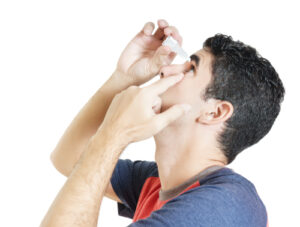
What’s better than spending time soaking up the sun? Here in Houston, it can feel like summer all year long. But for your eyes, it can take its toll in unexpected ways.
If you’ve noticed a pink, fleshy growth on the surface of your eye, you might have something called pterygium. Here’s the good news: you can get pterygium treatment and help your eyes feel better. Keep reading to learn the truth about pterygium treatment in Houston and what you need to know to keep your eyes feeling their best!
What is Pterygium?
Pterygium is a growth that forms on the conjunctiva. The conjunctiva is the clear tissue covering the sclera, the white part of the eye, and the eyelids’ lining.

These growths usually form due to excessive time spent outside in the sun, windy conditions, or sand without proper protection. Sound familiar?
Houston is nothing if not sunny and humid, after all. That makes it a perfect spot to develop a pterygium, also called surfer’s eye. If you have a pterygium, it can cause watering, tearing, redness, swelling, irritation, itching, and vision obstruction.
Spending a lot of time outside for your job because you work in construction or are a gardener outdoors more than most may increase your chances of developing pterygium.
How Do I Know If I Have One?
One thing that can make pterygium more challenging to understand is that its symptoms are not exclusive to the condition. Redness, irritation, watering, and tearing are all symptoms that you can experience with other conditions like dry eye syndrome.
You can also have other growths on the eye, including if you have a chalazion or a stye. A chalazion is a red bump or cyst on the eyelid that forms when an oil gland becomes blocked.
It may be painful at first, but the pain should dissipate. A stye, meanwhile, is a painful red bump that forms on the edge of the eyelid when an oil gland becomes blocked and then infected.
Chalazion and styes differ from pterygium because they do not form on the eye’s conjunctiva but affect the oil glands. So, how do you know if what you have is a pterygium?
Look at the location and what the growth looks like. A pterygium is usually thicker, pink, yellow, or red and is found on the cornea. It may be shaped like a triangle.
It will also usually cause your eyes to feel dry, and it may feel like there’s something stuck in your eye. If you have these symptoms together, combined with noticing a growth on your eye, there’s a good chance you have a pterygium.
How Did I Get Pterygium, Anyway?

Spending all that time in the sun during family gatherings, fiestas, or quinceañeras feels so good, right? But take a minute to think. Were you wearing sunglasses or a wide-brimmed hat while you were outside?
Probably not, because the time you spend outside without proper protection from the sun’s UV rays contributes to and increases your risk dramatically for developing pterygium. Whether outdoors because of your job or outside soaking up the warmth, protecting your eyes is a must!
After all, you’ve seen firsthand what can happen if you don’t. Pterygium seems like a nuisance, but it can also obscure your vision and make it harder to see things around you, which is less than ideal.

So, here’s what you can do. First, make a concerted effort to always wear sunglasses or a hat whenever you’re outside. Living in Houston, this is the smartest thing to do because it’s a lot hotter and more humid here than in other places, so your eyes will thank you.
Second, now that you have a far better understanding of pterygium, educate others about the condition. Do you have younger siblings, cousins, or nieces and nephews that might play outside and forget proper eye protection?
Remind them of the importance of sunglasses and hats when they are outdoors. A little extra reminder can never hurt, especially when keeping someone else’s eyes safe!
How Do You Treat Pterygium?

You think you have pterygium. What do you do now?
The first step is to schedule a free consultation at Mattioli Vision Professionals, where you can find out if you’re a good candidate for pterygium excision.
Pterygium excision is only appropriate for certain candidates, including those at least 18 years old and in good health. If you are a good candidate, excising pterygium is the most effective way to treat pterygium.
Most patients choose to have pterygium removed if it’s causing irritation, vision obstruction, or because they don’t like the way it looks. Having pterygium can also obscure the center of the cornea, which may induce astigmatism or corneal scarring.
Is There a Long Recovery Period if I Have Pterygium Removed?

Once you have pterygium excised, you don’t have to worry about a lengthy recovery period keeping you from doing your favorite things, like catching a Houston Astros game or running in Buffalo Bayou Park. After the procedure, you’ll need to use over-the-counter lubricated eye drops, preservative-free ointments, and eye drops to reduce inflammation.
Most patients can return to everyday routines within 48 hours following pterygium excision. Remember, it can take about 2-3 weeks before your eye will look the way it usually does after the procedure.
Avoid physical activity and exercise for two weeks after pterygium excision to help reduce the risk of irritation and swelling. Assuming you follow all recommendations from your ophthalmologist at MVP Eyes, you’ll recover quickly and return to what you love before you know it!
How Do I Keep My Pterygium from Coming Back?

Although you can’t guarantee your pterygium won’t return, you can decrease your chances of recurrence. What are the best things you can do?
Practice proper sun protection whenever you’re outdoors! Using wide-brimmed hats, sunglasses with UVA and UVB protection, and umbrellas to shield you from the sun are a must if you’re spending time outside!
Need to take the next steps regarding pterygium treatment? Start by scheduling your appointment today at Mattioli Vision Professionals in Houston, TX!
